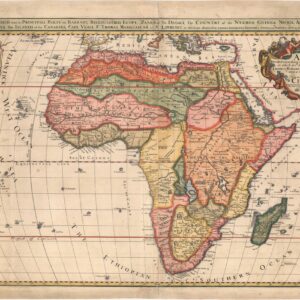A gorgeous pictorial tourist map of Algeria in the 1960s.
Algerie.
Out of stock
Description
Travel poster artists often use cartography to help situate and entice the viewer. There is something wildly romantic yet comfortingly familiar in maps, making them an ideal means to endow a given place with allure. This is undoubtedly the case for this charming and vivacious map of Algeria, produced by the government to boost the local tourist industry.
Algeria’s recent political troubles have kept tourists away for decades now (expounded in the context section below), but this map belongs to a more distant past; to the heydays of the 1960s and 70s when the former French colony still appealed deeply to European and American audiences as a holiday destination. All that Algeria had to offer during those formative years is touted in this feel-good pictorial map of the country.
As is shown on the map, most of Algeria’s bounty is located along the Mediterranean coastline. Here, fertility and abundance are thick on the ground. Among the wealth of vignettes, we find numerous references to tourist attractions, from freshly grilled sea breams to beach-front parasols. In the upper left corner, viewers are treated to a stylized depiction of the old casbah in Algiers, of which virtually nothing original remains. This contradiction is evident from the illustration, for even though it oozes Oriental atmosphere, with its stylized minaret and bazaar, the image offers no clues to anchor it in any reality.
The abundance theme is maintained in the upper left side of the map, where Algerians in traditional garb occupy another stylized market scene. While the stalls themselves are not visible, the richness of the stores is represented below the scene with colorful fruits, nuts, and vegetables. Below this, at the bottom of the map, is some of the items that tourists in North Africa seem to love so much: Atop a woven Berber rug, we find both traditional jewelry and decorated ceramics; some of the most common trophies brought home by visiting Europeans.
South of the Algerian coastline, one primarily finds the empty sands of the Sahara, which constitute around 90% of the country. But as this poster map makes evident, this arid region is not without value. The country has been a major oil producer since its initial discoveries in 1956, and much of its post-colonial wealth comes from this particular natural resource. Along the roads leading from the densely inhabited coastline to the isolated oil rigs of the south, one finds plantation after plantation producing some of the most sumptuous and expensive dates in the world. Below the many oil rigs, we find a pictorial legend that leaves viewers with the feeling of Algeria as a prosperous nation, one well worth a visit.
The map touts the development of infrastructure and oil rigs as great monuments of modernity. The national wealth and creature comforts that oil money brought into the fledgling country, and to which westerners had grown very accustomed, was a point worth making. Below the casbah image in the upper right corner, we find the organization behind this visual tour-de-force. The OFALAC Alger or Office Algérien d’Action Commerciale was the government organ responsible for developing the national economy through trade and investment, and an essential part of that job consisted of luring people to Algeria in the first place.
The notion that foreigners would be interested in visiting Algeria was not far-fetched. France had been using it as a vacationing paradise since the early 1900s. In fact, one might argue that it was the French who began compiling such pictorial maps to sell holiday packages, but the Algerians were quick to adapt when the opportunity arose. Algeria did not win its independence from France until they fought a long and bloody war of independence (1954-62). Beginning shortly after that, the Algerian government – and later the OFALAC – published a series of pictorial maps intended for tourists. This map is among the most vividly outstanding examples of that impressive oeuvre.
Context is everything
Algeria used to be considered one of the best places in North Africa for European tourists to visit. It was like a North African version of the south of France, with modern coastal cities stretched out along Parisian-style boulevards. This role has been lost over the past thirty years due to a violent internal conflict between the democratically elected Front Islamique du Salut and Algeria’s military government and puppet president (the latter held in place by France and other former colonial powers following the legitimate election of FIS in 1991). Peace was not achieved until 2002 when the military finally overwhelmed the FIS partisans and brought them to their knees. The situation is changing for the better, and Algeria no longer struggles with violent civil war. Consequently, the country is again opening up to tourism, giving maps like this a new lease of life.
In general, Algeria has much to offer visitors. It is the largest country on the African continent, although it consists mainly of the shifting sands of the Saraha. The desert is nevertheless ripe with natural resources such as oil and gas, providing Algeria with the means to rebuild its country. Unlike Morocco and Tunisia, Algeria was the subject of a sweeping French modernization movement during the colonial period. Spearheaded by French General Lyautey, the modernization strategy caused all of the ancient cities along the coast to be completely demolished and then rebuilt as modern French cities. For all intents and purposes, Algeria had its historic heart ripped out by bulldozers, but the practice also meant that Algeria’s coastal cities became modern metropolises that appealed to European, and especially French, sensibilities.
Ultimately, while it may draw on common cartographic and commercial practices in Europe, this vivacious map reflects Algeria’s national confidence following a long and bloody struggle for independence. It is a token of national pride and the manifestation of deep-rooted optimism that Algeria faces a bright and illustrious future.
Cartographer(s):
Condition Description
Very good.
References
![[Title on Verso] Tabula Prima Aphricae Continent Mauritania Tingitanam, & Mauritaniam Caesariensem](https://neatlinemaps.com/wp-content/uploads/2019/09/NL-00293_Thumbnail-300x300.jpg)
![[Title on Verso] Tabula Prima Aphricae Continent Mauritania Tingitanam, & Mauritaniam Caesariensem](https://neatlinemaps.com/wp-content/uploads/2019/09/NL-00293_r-scaled-300x300.jpg)


![[3-Sheet Biodiversity Map of Madagascar] Carte Internationale du Tapis Végétal et des Conditions Écologiques.](https://neatlinemaps.com/wp-content/uploads/2024/05/NL-01035-middle_thumbnail-300x300.jpg)